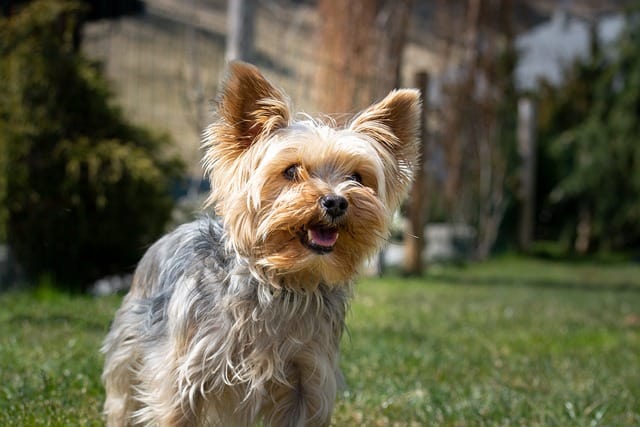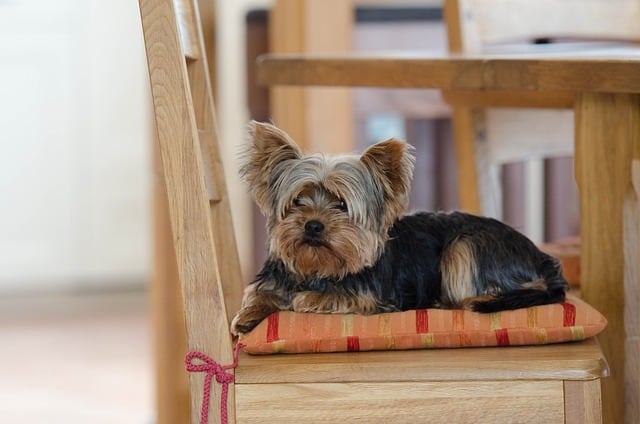Blog
Understanding Your Yorkie Heat Cycle: A Pet Parent’s Guide

If you’re an owner of this tiny pup, then you’d probably would like to know everything about heat cycle in your Yorkie. Since it’s a normal occurrence in all female pups, you gotta be prepared for this stage and know what to expect. To help every pet parent who’s in panic, we decided to reveal all the things you need to know about Yorkie heat.
A heat cycle, also known as estrus, is a part of the reproductive cycle in female dogs where they become receptive to mating. Yorkies typically experience their first heat around six to twelve months of age, but this can vary.

Signs and Symptoms of Yorkie Heat
As a Yorkie owner, understanding when your little companion is entering her heat cycle is crucial. This knowledge helps in providing the right care and also in preventing unwanted pregnancies if you’re not planning to breed her. So, how do you know when your Yorkie is in heat? Here are some tell-tale signs and symptoms:
1. Physical Changes:
- Swelling of the Vulva: This is often the first noticeable sign. You might see that your Yorkie’s vulva becomes enlarged and puffy.
- Vaginal Discharge: At the onset of heat, the discharge may be bloody, turning to a straw color as the cycle progresses. This is entirely normal.
2. Behavioral Changes:
- Increased Affection or Clinginess: Your Yorkie might become unusually affectionate, seeking more attention and physical contact than usual.
- Restlessness and Agitation: She may seem more restless, pacing around the house or whining more than usual. Some Yorkies can even become aggressive.
- Changes in Urination: Frequent urination or marking behavior can be a sign. This is part of their natural instinct to signal their availability to potential mates.
- Nesting Behavior: Some Yorkies may start creating a nest or rearranging their bedding area.
3. Appetite Fluctuations:
- You might notice a change in her eating habits. Some Yorkies eat more, while others may lose their appetite during heat. In both cases, you should pay attention to your Yorkie’s food intake and take her to the vet if she goes from one extreme to another extreme.
4. Attraction of Male Dogs:
- If you notice more male dogs loitering around your house, it’s a strong indicator that your Yorkie is in heat. Male dogs can detect the scent of a female dog in heat from miles away.
5. Licking Her Genital Area:
- Increased licking of the genital area is common. This is a way for your Yorkie to keep herself clean.
6. Yorkie Tail Positioning:
Also known as “flagging,” your Yorkie might position her tail to the side, which is a mating posture.
How to Manage The Signs of Yorkie Heat?
As an owner, understanding these signs helps you to better care for your Yorkie during this time. Here are some tips:
- Keep her on a leash during walks to avoid unwanted attention from male dogs.
- Consider using doggy diapers to manage discharge and maintain hygiene.
- Provide a quiet and comfortable space where she can rest.
- Stay patient and give her extra love and attention to help ease her discomfort.

How Long Does Heat Last in Yorkies?
When it comes to understanding the heat cycle of your Yorkie, one of the most common questions is, “How long does the heat last?” Generally, a Yorkie’s heat cycle can last anywhere from 2 to 4 weeks, with an average of 3 weeks. However, this duration can vary slightly from dog to dog.
The heat cycle in Yorkies, like in other dogs, is divided into several stages:
- Proestrus: This is the beginning stage, lasting about 9 to 10 days. During this phase, your Yorkie might show initial signs of heat like vulva swelling and bloody discharge, but she is not yet receptive to males.
- Estrus: Following proestrus, your Yorkie enters the estrus phase, which is when she is fertile and receptive to mating. This stage also lasts for about 9 to 10 days.
- Diestrus: The diestrus stage signals the end of the heat cycle. If your Yorkie is not pregnant, her body will start to return to normal.
- Anestrus: This is the resting stage before the cycle begins again.
As a Yorkie owner, it’s important to keep track of these cycles, especially if you are not planning to breed your dog. Keeping her away from male dogs during the estrus phase is crucial to prevent unwanted pregnancies. Also, consider this time to provide extra care and attention as she might experience physical and emotional changes.
When Should a Female Yorkie Be Spayed?
Spaying your female Yorkie is a significant decision that can impact her health and behavior. The best time to spay a female Yorkie is generally between 4 to 9 months of age. However, the exact timing can vary based on individual health, size, and lifestyle factors.
Spaying before the first heat cycle can offer several health benefits, such as reducing the risk of mammary tumors and uterine infections like pyometra. It also eliminates the risk of unwanted pregnancies and some of the behavioral issues associated with the heat cycle.
However, it’s essential to consult with your veterinarian to determine the best timing for spaying your Yorkie. They can provide guidance based on your dog’s specific health needs and development. Early spaying requires careful consideration, especially for small breeds like Yorkies, as they can have unique developmental and health concerns.
Remember, spaying is a surgical procedure that requires proper post-operative care. Your vet will provide instructions on how to care for your Yorkie after the surgery to ensure a smooth and safe recovery.
What Age do Male Yorkies go into Heat?
It’s important to clarify that male Yorkies, or male dogs in general, do not go into ‘heat’ like females do. Instead, male dogs become sexually mature and capable of breeding. For male Yorkies, this usually occurs around 6 to 12 months of age. However, this can vary with each individual dog.
Once they reach sexual maturity, male Yorkies can exhibit behaviors such as mounting, marking territory more frequently, and showing interest in female dogs. Unlike female dogs, males do not have a cyclical reproductive pattern, meaning they can be ready to mate at any time once they reach maturity.
As a responsible Yorkie owner, it’s important to manage these behaviors, especially if you’re not planning to breed your dog. Neutering can be a viable option to consider. It not only helps in controlling unwanted breeding but also can certainly helps in reducing unwanted behaviors and providing health benefits.

Yorkie Heat: Wrapping Up
The heat cycle is a natural part of your Yorkshire Terrier’s life, and understanding it equips you to provide the best care. Remember, each dog is an individual, and what works for one may not work for another. Regular consultations with your veterinarian, tailored care, and your unwavering love and attention will ensure your Yorkshire Terrier thrives.
